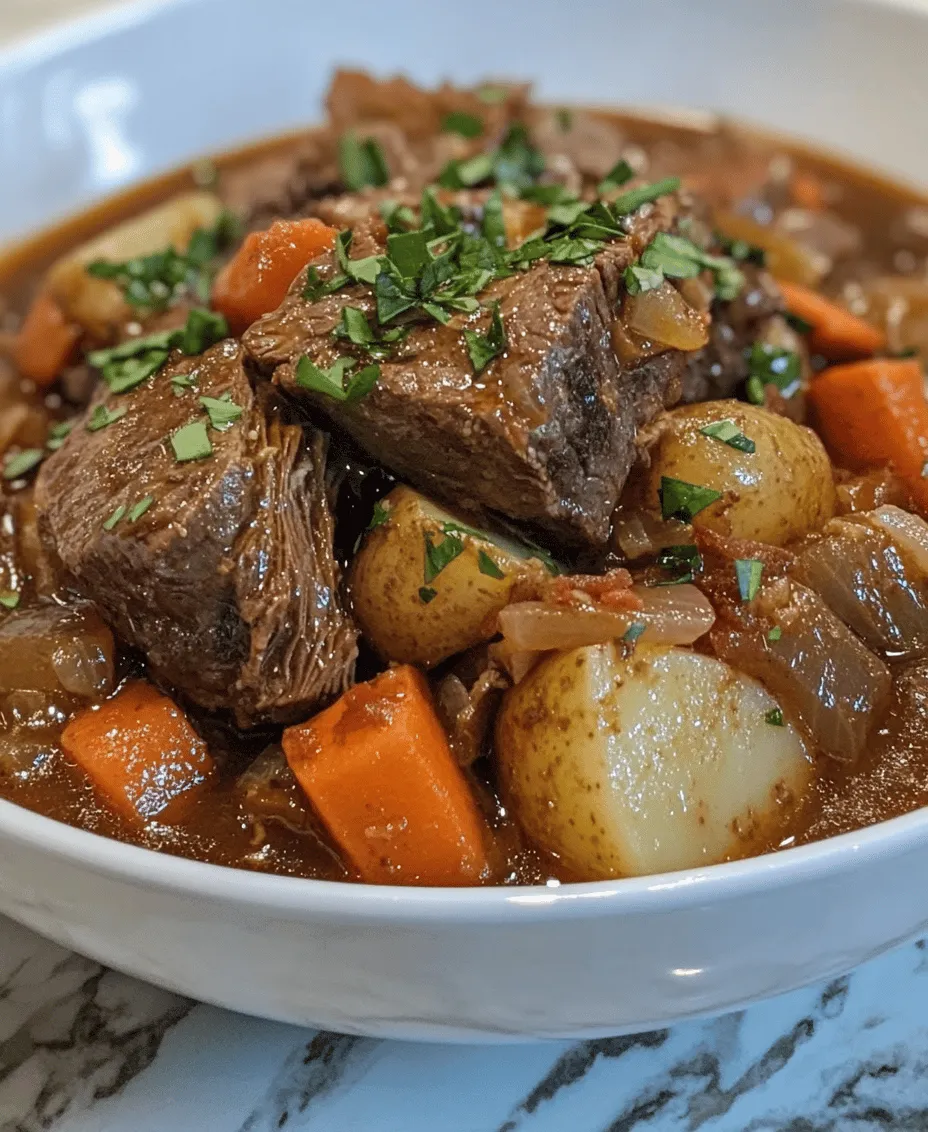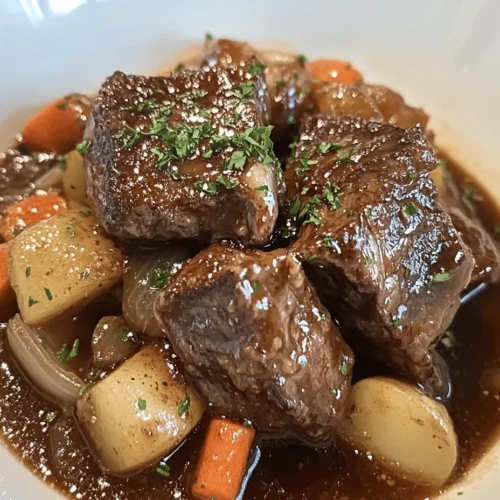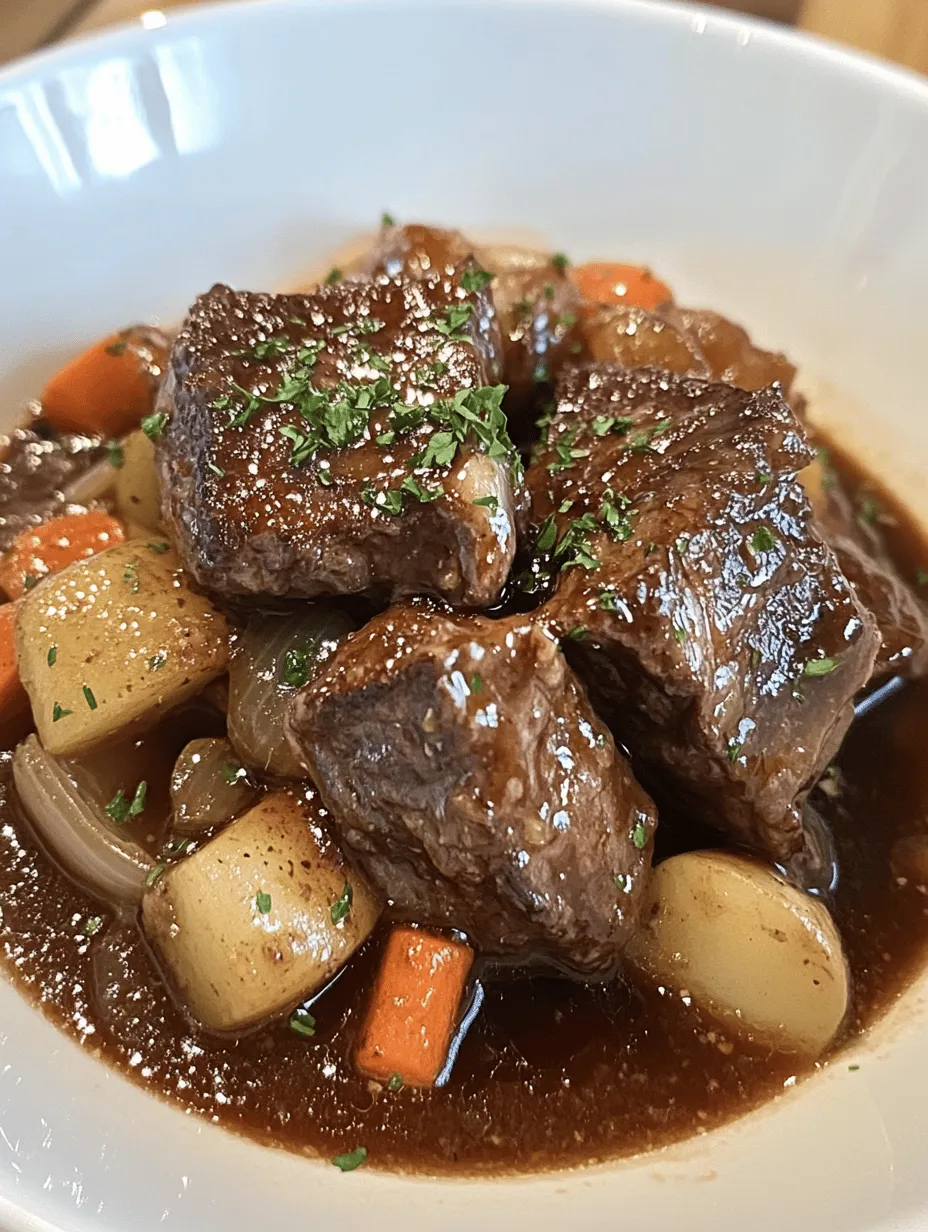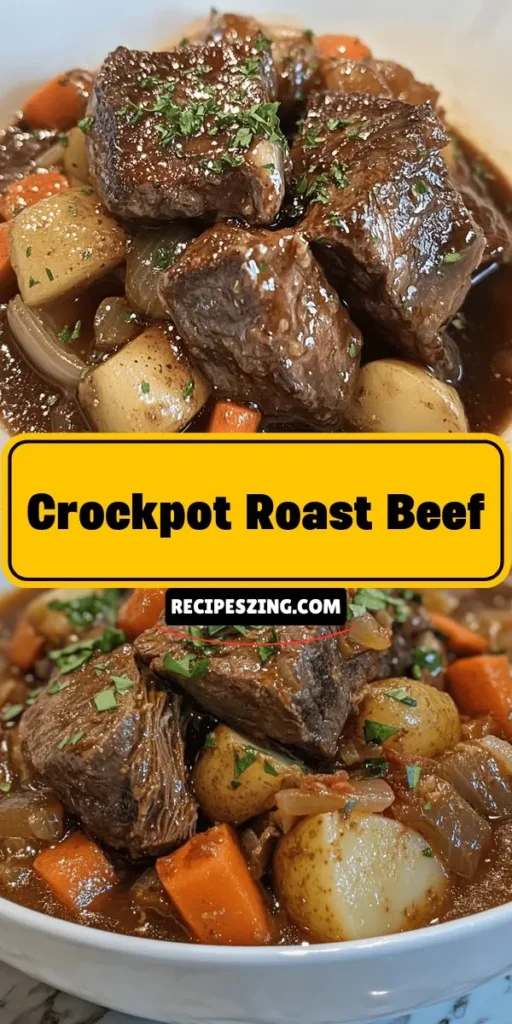Introduction
There’s something undeniably comforting about a slow-cooked meal. The tantalizing aroma that fills your home as ingredients meld together over hours creates an inviting atmosphere, making it a perfect dish for family gatherings or a cozy weeknight dinner. Among the myriad of slow-cooked recipes, the Rustic Crockpot Roast Beef stands out as a beloved classic, cherished for its rich flavors and melt-in-your-mouth tenderness.
This recipe not only highlights the convenience of using a crockpot but also showcases a symphony of flavors that come together to create a savory delight. With minimal prep time, the crockpot does the heavy lifting, allowing you to focus on other tasks or simply enjoy a well-deserved break while dinner cooks itself. Whether you’re looking to impress guests or simply treat your family to a hearty meal, this roast beef recipe is sure to become a staple in your culinary repertoire.
Understanding the Ingredients
A successful Rustic Crockpot Roast Beef relies on carefully chosen ingredients that work in harmony to elevate the dish. Each component plays a crucial role in creating that unforgettable flavor profile. Here’s a closer look at the key ingredients:
Beef Chuck Roast: Importance of Cut for Tenderness
The star of this recipe is the beef chuck roast, known for its rich marbling and robust flavor. This cut is derived from the shoulder area of the cow, which is a well-exercised muscle, giving it a wonderful texture that becomes incredibly tender when cooked slowly. The marbling of fat throughout the meat not only enhances flavor but also ensures that the roast remains juicy throughout the cooking process. Choosing a high-quality beef chuck roast is vital for achieving the best results, so opt for grass-fed or organic beef whenever possible for a superior taste.
Olive Oil: Aiding in Flavor and Moisture
Before the roast even hits the crockpot, a light coating of olive oil is essential. This ingredient serves multiple purposes: it adds depth of flavor, aids in moisture retention, and promotes a beautiful sear if you choose to brown the meat beforehand. Additionally, olive oil is rich in healthy fats, making it a heart-friendly option. Its slightly fruity notes complement the savory elements of the dish, enhancing the overall taste.
Spices and Herbs: Enhancing the Dish’s Depth
A blend of spices and herbs is crucial for transforming a simple roast into a culinary masterpiece. Commonly used seasonings include garlic powder, onion powder, paprika, salt, and pepper. Fresh herbs like thyme and rosemary can also be added for a fragrant touch. The combination of these spices not only enhances the beef’s natural flavors but also adds layers of complexity that will have everyone asking for seconds. Feel free to adjust the spices according to your preference; the beauty of cooking is in the ability to make each dish your own.
Vegetables: Adding Nutrition and Flavor
Vegetables are not merely an afterthought in this recipe; they play a significant role in flavor and nutrition. Common additions include carrots, potatoes, and onions, which contribute sweetness and earthiness to the dish. Each vegetable adds its unique texture and flavor, creating a well-rounded meal. Carrots provide a natural sweetness that balances the savory meat, while potatoes absorb the rich juices, becoming tender and flavorful. Onions lend a subtle sweetness and depth, enhancing the overall taste profile.
Broth and Vinegar: Creating a Rich Sauce
To achieve a luscious sauce that ties the dish together, the addition of beef broth and a splash of vinegar is essential. Broth infuses the meat with moisture and flavor, while vinegar adds a touch of acidity that brightens the overall dish. This combination not only contributes to the sauce’s richness but also helps to tenderize the meat during the cooking process. You can use homemade broth for an extra layer of flavor, or store-bought options work just as well for convenience.
Preparation Steps Explained
Now that we’ve covered the ingredients, it’s time to delve into the preparation steps that set the foundation for this delicious meal. Each step is designed to maximize flavor and ensure a perfectly cooked roast.
Detailing the Preparation of the Beef
Start by preparing your beef chuck roast. It’s essential to pat the roast dry with paper towels to remove excess moisture. This step is crucial for achieving a good sear, which locks in flavors and creates a beautiful crust. Once dried, season the roast generously with salt and pepper, ensuring every bit is coated. The seasoning not only enhances the meat’s flavor but also helps to create a delicious crust during searing.
Importance of Patting Dry and Seasoning
Patting the roast dry is a simple yet vital step that many home cooks overlook. Moisture on the surface of the meat will prevent it from browning properly. When you season the beef, make sure to use a liberal amount of salt and pepper, as this will enhance the overall taste of the dish and create a flavorful crust when seared.
Explanation of Optional Searing for Enhanced Flavor
While searing the meat is an optional step, it can significantly elevate the flavor of your roast. Heat a tablespoon of olive oil in a large skillet over medium-high heat. Once the oil is hot, carefully place the roast in the skillet and sear each side for about 3-4 minutes until a golden-brown crust forms. This step creates a depth of flavor through the Maillard reaction, where the sugars and amino acids in the meat react to heat, enhancing the overall taste of the dish. After searing, transfer the roast to the crockpot, and you’re ready for the next step.
Layering the Vegetables in the Crockpot
Next, it’s time to prepare the vegetables. Start by chopping your chosen vegetables into uniform pieces to ensure even cooking. Begin layering the chopped onions, carrots, and potatoes at the bottom of the crockpot. This vegetable base serves two purposes: it elevates the meat, allowing it to cook evenly, and it infuses the dish with flavor. As the roast cooks, the vegetables will absorb the savory juices, becoming incredibly tender and flavorful.
Benefits of Using a Vegetable Base for Flavor Infusion
Using a vegetable base in the crockpot not only enhances flavor through infusion but also adds moisture to the roast. The vegetables will release their natural juices during cooking, creating a flavorful broth that melds beautifully with the beef. This technique also promotes even cooking, as the vegetables help distribute heat evenly throughout the roast.
Recommended Vegetable Variations
While carrots, potatoes, and onions are traditional choices, feel free to get creative with your vegetable selection. Other excellent options include parsnips, celery, or even mushrooms, which can add an earthy flavor. Consider seasonal vegetables for a fresh twist or add some bell peppers for a pop of color. The versatility of this recipe allows you to customize it to your liking, making it a canvas for your culinary creativity.
Cooking Process
With the preparation complete, it’s time to set up the crockpot and initiate the cooking process. This is where the magic truly happens, and your kitchen will be filled with mouthwatering aromas.
Step-by-Step Guide on How to Set Up the Crockpot
To set up your crockpot, start by placing the layered vegetables at the bottom, followed by the seasoned roast on top. This arrangement ensures that the meat is elevated above the moisture, allowing it to cook evenly. Next, pour in the beef broth, ensuring the roast is partially submerged in liquid. This helps to create a tender, juicy roast while also forming a delicious sauce.
Importance of Liquid Ratios for Optimal Cooking
When it comes to slow cooking, the ratio of meat to liquid is crucial. Too much liquid can lead to boiling rather than slow cooking, while too little can result in dry meat. A general rule of thumb is to use around 1 to 1.5 cups of liquid for a 3-4 pound roast. This amount will allow the beef to braise gently, breaking down tougher muscle fibers and rendering the meat tender and flavorful.
Discussion on Low Versus High Cooking Settings
Crockpots typically offer low and high cooking settings, each with distinct advantages. Cooking on low heat (around 200°F) for 8-10 hours allows the flavors to deepen and the meat to become incredibly tender. This method is ideal for those who want to set it and forget it while at work or running errands. On the other hand, if you’re short on time, the high setting (around 300°F) can produce a delicious roast in 4-6 hours. However, keep in mind that cooking on high may not yield the same depth of flavor or tenderness as low and slow cooking.
Understanding the Cooking Times and Their Impact on the Final Texture of the Meat
The cooking time you choose directly impacts the final texture of the roast. For an ideal outcome, aim for a cooking time that allows the connective tissues in the beef to break down fully. This process is essential for achieving that melt-in-your-mouth texture that defines a perfect crockpot roast. As a general guideline, plan for about 8 hours on low or 4-5 hours on high, checking for doneness with a fork; the meat should shred easily when it’s fully cooked.
In the next section of this article, we will explore serving suggestions, allowing you to present your Rustic Crockpot Roast Beef in the most appetizing way possible. Stay tuned for tips on pairing sides and enhancing the dining experience with this delectable dish!

Ideas for Side Dishes that Complement the Roast
When serving your Slow-Cooked Savory Delight: Rustic Crockpot Roast Beef, the right side dishes can elevate your meal to new heights. Here are some ideas that ensure a harmonious balance of flavors and textures:
1. Creamy Mashed Potatoes: The classic pairing of mashed potatoes with roast beef is a must. The creaminess of the potatoes complements the savory flavors of the beef, and you can enhance them with garlic or cheese for an extra flavor kick.
2. Roasted Vegetables: Seasonal roasted vegetables like carrots, Brussels sprouts, and sweet potatoes add color and nutrition to your plate. Toss them with olive oil, salt, and your favorite herbs before roasting for a charred, flavorful side.
3. Green Beans Almondine: Sautéed green beans with toasted almonds offer a crunchy texture and a light, nutty flavor that pairs beautifully with the richness of the roast beef.
4. Scalloped Potatoes: For something a bit more indulgent, scalloped potatoes layered with cheese and cream create a comforting addition to your meal.
5. Yorkshire Pudding: This traditional British side is perfect for soaking up the delicious gravy from the roast. Light and airy, Yorkshire pudding can be made with the drippings from the beef for an authentic flavor.
Suggestions for Bread or Grains
The right bread or grains can enhance the dining experience and make the meal feel complete:
1. Crusty Artisan Bread: A loaf of freshly baked crusty bread allows diners to soak up the rich juices from the roast. Look for sourdough or a rustic country loaf for the best flavor.
2. Couscous or Quinoa: For a lighter option, consider serving a fluffy couscous or nutty quinoa that can be lightly seasoned with herbs or citrus. These grains can act as a bed for the roast, absorbing the flavors beautifully.
3. Polenta: Creamy polenta can provide a comforting and hearty base for the roast, offering a delightful contrast in texture.
Pairing with Salads or Pickled Vegetables
Adding a fresh salad or pickled vegetables can brighten up the meal:
1. Mixed Greens Salad: A simple salad with mixed greens, cherry tomatoes, cucumbers, and a light vinaigrette can cleanse the palate and provide a refreshing contrast to the rich beef.
2. Coleslaw: A tangy coleslaw made with cabbage and carrots can add crunch and acidity, balancing the flavors of the roast.
3. Pickled Vegetables: A selection of pickled vegetables, such as pickled onions or beets, can provide a tangy bite that complements the savory notes of the beef.
Tips for Serving and Presentation
The presentation of your Rustic Crockpot Roast Beef can make a significant impact on your dining experience. Here are some tips:
– Serving on a Wooden Board: Place the roast on a rustic wooden cutting board for a charming presentation. This not only looks appealing but also adds to the homey feel of the meal.
– Slicing with Care: When ready to serve, slice the roast against the grain to ensure tenderness. Serve slices on individual plates or family-style on a platter.
– Drizzling with Gravy: Don’t forget to generously drizzle the roast with the rich gravy made from the cooking juices. This adds moisture and enhances the visual appeal.
Garnishing with Fresh Parsley and Serving Style
A simple garnish of fresh parsley can elevate the dish:
– Chopped Fresh Parsley: Sprinkle chopped fresh parsley over the roast before serving. This adds a pop of color and freshness, contrasting beautifully with the dark, rich meat.
– Serving Style: Consider serving the roast in a buffet-style setup, allowing guests to help themselves. This encourages a communal atmosphere, perfect for family gatherings or dinner parties.
Nutritional Information
Understanding the nutritional content of your meal can help you make informed choices:
– Calories per Serving: A typical serving of Rustic Crockpot Roast Beef contains approximately 350-450 calories, depending on the cut of meat and the amount of gravy served.
– Protein and Fats: Each serving provides about 30-35 grams of protein, making it a hearty option for those looking to boost their protein intake. The fat content can vary based on the cut used, ranging between 15-25 grams.
– Carbohydrates: If served with sides like mashed potatoes or bread, the carbohydrate count can increase significantly, but the roast itself contains minimal carbs.
– Health Benefits: The ingredients used in the roast, particularly lean cuts of beef, provide essential nutrients such as iron, zinc, and B vitamins, promoting overall health. Additionally, vegetables used during cooking contribute fiber and vitamins.
– Dietary Adjustments: For those with dietary restrictions, consider using gluten-free thickeners for the gravy or opting for low-carb sides like cauliflower mash.
Variations and Adaptations
Your rustic roast can be customized to suit different tastes and dietary needs:
– Alternative Ingredients: Experiment with different herbs and spices to create new flavor profiles. For example, adding rosemary and thyme can introduce an aromatic quality, while a sprinkle of cumin can add warmth.
– Different Cuts of Meat: While chuck roast is ideal for slow cooking, consider alternatives like brisket or round roast for variations in texture and flavor.
– Vegetarian Adaptations: For a vegetarian take, substitute the beef with hearty mushrooms or tempeh, marinated in a similar sauce. This maintains the essence of a comforting meal while catering to plant-based diets.
– Customizing Spice Levels: Adjust the heat by incorporating chili flakes or smoked paprika. This adds depth and warmth to the dish.
Storing and Reheating Leftovers
Proper storage and reheating can help maintain the quality of your roast:
– Best Practices for Storing Leftovers: Allow the roast to cool completely before transferring it to an airtight container. It can be stored in the refrigerator for up to three days or frozen for up to three months.
– Recommended Container Types: Glass containers with tight-fitting lids work well for both refrigeration and freezing, ensuring the meat stays fresh.
– Reheating Methods: To preserve flavor and texture, reheat leftovers slowly. For stovetop reheating, place the roast in a skillet over low heat, adding a splash of beef broth or water to keep it moist. For microwave reheating, cover the dish with a microwave-safe lid, heating in short bursts to avoid drying out the meat.
Conclusion
Making Rustic Crockpot Roast Beef is not only easy but also a rewarding experience that fills your home with delightful aromas and brings loved ones together. The slow cooking process melds flavors beautifully, resulting in a tender and savory dish that everyone will enjoy.
We encourage you to try this recipe and share the joy of a hearty meal with your family and friends. The beauty of slow cooking lies in its simplicity and the way it transforms everyday ingredients into a remarkable feast. Embrace the art of slow cooking and savor the delicious results that come from taking your time in the kitchen.



